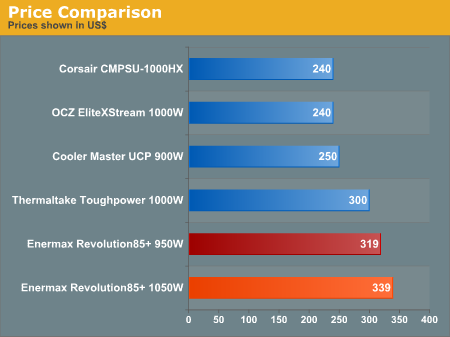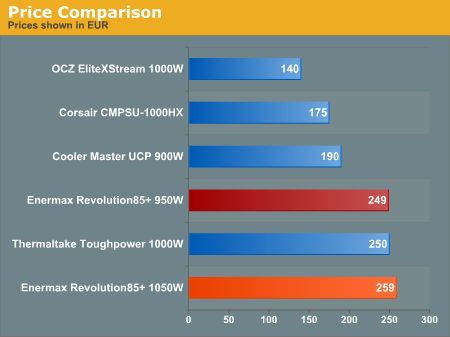Enermax Revolution 85+ High Efficiency PSU
by Christoph Katzer on November 6, 2008 4:15 AM EST- Posted in
- Cases/Cooling/PSUs
Conclusion
Our expectations for this power supply were very high, but we are happy to say that it met its potential in every way. Beauty as always is in the eye of the beholder, but we do like the appearance of the Revolution 85+. The original sample was far more conservative in its design, and when Enermax told us they were revising the look we didn't think it was necessary, since it would probably just increase the price. However, we have to say that the final result does look really cool. The combination of the black textured surface with the red highlights around the fan grille is very attractive in our opinion.
The feature list is similarly impressive, even though most users will not see or recognize some of the innovations. Enermax included a lot of new technologies in this power supply, and the results are very good. It starts with a good topology that lets the two transformers act in synchronization. Another nice feature is the DC-to-DC circuitry that increases efficiency. The not new but still good addition of the 12-pin sockets on the front of the power supply give potential support for future connector developments -- provided of course that the voltage requirements don't change.
The length of the ATX and PEG cables is long enough for most systems. However, if you want to install this power supply in a case where the PSU is in the top rear and the hard drives are in the bottom front, you may have some difficulties getting the cables to reach. Likewise, if the PSU sits in the bottom of your case you might not be able to route all of the cables nicely through the chassis but will have to take a more direct path. The eight 6/8-pin PEG connectors are very nice and make this power supply ready for any GPU configuration all the way up to triple SLI and more. If you're going to use multiple graphics cards, this PSU will likely work best in a bottom-mounted location.
Build quality has never been a concern with Enermax products. About the only problem we've ever encountered were some incompatibilities in the past with a few specific motherboards. Those issues never occurred with higher end PSUs, however, and the Revolution 85+ is clearly the highest of their high-end power supplies. They have included all of the best features from their previous offerings, plus a few new ones for good measure. All of this adds up to the tremendous performance we saw today.
Voltage regulation was good and not even our 10% overload test could cause this unit to sweat. The efficiency is the best we have seen from any previous power supply to date. Enermax states on the package that up to 90% efficiency is possible, and we achieved exactly that with 230VAC. Even with a lower 120VAC input, efficiency still reached an incredible 88%. As mentioned, optimal efficiency generally requires a minimum load of 200W; if you have a system that idles above 200W, you won't need to worry about power supply efficiency for a long time.
Another nice feature is the no load function. As we hinted at earlier, we loaded the power supply using only the 12V rails, keeping the lower voltage 3.3V and 5V rails load-less. We had no trouble at all pulling up to 1000W on the 12V rails without any lower voltage rails, and the PSU still maintained a very nice regulation of just a few millivolts under 12.00V. Of course, with a DC-to-DC circuit the power supply has no total combined power anymore. For reference, when we tried this test on other power supplies, they immediately shut down when either the 3.3V or the 5V rail didn't have any load.
 |
The heatsinks stayed very cool during testing, with temperatures lower than 40°C. Only after running at 110% for a longer period of time did we manage to get heatsink temperatures above 40°C. The fan speed begins increasing with 500W of load and actually lowers temperatures slightly for a while; it's only from 1050W onwards that the heatsink temperatures rise again and the fan can't quite keep up. The drawback is that noise levels are slightly higher than the temperatures warrant; we measured only 29dB(A) under highest load which is still an extraordinary result, but it should have been possible to keep noise levels down even further since the heatsinks aren't that hot at all. Still, it's always better to have a cooler running power supply than to toe the line, which is why Enermax regulates temperatures and fan speeds in this fashion. Keeping the internals at around 40°C at all times is not at all a bad approach, and this should increase the lifespan for this power supply.
Let's compare this unit to other 1000W units and see where it fits. Let's start with the Cooler Master UCP, since there are similarities with the Enermax Revolution 85+. The Revolution 85+ comes with about the same amount of cables and connectors. The PEG connection options are similar but the UCP has them further from the PSU, which is better for users since that provides for better cable routing options. However, Enermax has six 6/8-pin PEG connectors, giving the user greater flexibility. The Corsair HX1000W is also very similar. Compared to units from our 1000W roundup last year, the Enermax Revolution 85+ outperforms all of them. There are more connectors on power supplies now, since manufacturers have discovered that they have plenty of headroom. Power supplies also sport 6/8-pin connectors as well rather than just providing 6-pin PEG, which is a good addition.
In voltage distribution, we don't see really much difference between the Revolution 85+ and many of the competing units tested this year. The Corsair HX1000W has a very good regulation as well, so the Enermax unit has no advantage in this regard. However, when it comes to efficiency there's not much to compare -- after all, we already said the Revolution 85+ is the most efficient power supply we have tested to date. The HX1000W achieves up to 86% and the Cooler Master UCP is close with up to 89% efficiency. This brings Cooler Master back into the game, but if we compare all the additional features (i.e. safety and protection) Enermax leaps ahead again.
The final comparison is pricing. Since each "revolutionary" product that enters the market is usually more expensive than the preceding units, we are not expecting wonders here. We'll let the numbers do the talking:


As expected the MSRP for both units we listed is far above everyone else in the U.S. The Corsair HX1000W is similarly equipped with connectors and offers a wide range of features as well. For a price of around $240 it is a true bargain compared to the others in the list. Still, the Enermax Revolution 85+ offers more and we need to keep in mind that we are using MSRP for now -- street prices will almost certainly be lower. In Europe OCZ sells its EliteXStream for an extremely low price of only 140€, but the others all come close to the Enermax MSRP. Prices should also drop as availability improves, though Enermax will keep it above a certain level as we have seen with the Galaxy series. Enermax knows its advantages over the competition and that will result in prices that should stabilize slightly higher than competing products.
 |
Even though these power supplies are anything but cheap, we are confident in making the statement that the Enermax Revolution 85+ is currently the most advanced consumer power supply available. It offers exceptional efficiency, voltage regulation, temperatures, and has very good build quality. It doesn't necessarily surpass the competition in every area, but it's always at the top of the charts. Ultimately, the innovations, feature set, and performance impress us so much that we are pleased to award the Enermax Revolution 85+ our Gold Editors' Choice Award. It's entirely possible that if you purchase the 1050W model, you could end up running the same PSU for the next couple of presidential elections -- and you can do so knowing your PC will be as green as a hybrid SUV.










49 Comments
View All Comments
strikeback03 - Friday, November 7, 2008 - link
You should have stated you were using a 700W power supply, your post indicated you thought you were drawing 700W.http://www.anandtech.com/casecoolingpsus/showdoc.a...">http://www.anandtech.com/casecoolingpsus/showdoc.a...
I have a similar system on my desk here at work (only 3 GHz on the q6600, but it is a B3 stepping; 2 HDD, 1 optical, 7300GT instead 0f 9800GX2) and idle is about 100 W at the wall, peak draw is like 160-170. Your system probably draws another 120-150W at idle, and maybe 250 at full power. A 700W power supply is quite reasonable for that system, as it probably uses 200-250 at idle and another 150-200 at full bore. It won't draw 700W.
Freddo - Thursday, November 6, 2008 - link
This PSU is so cool, as it's very energy efficient & have modular cables.I would really like to see a PSU as energy efficient as this one, but down at ~400W or so instead, and with passive cooling, or at least "half passive", with a small 80mm fan outwards that only starts to spin when it's near full load and getting hot.
Christoph Katzer - Thursday, November 6, 2008 - link
Wait until next year's ~CES/CeBIT, there is a manufacturer who might have exactly what you're waiting for...iwodo - Thursday, November 6, 2008 - link
As Anand as well as other tech site has confirm, even with GTX SLI and Quad Core CPU, you will hardly need more then 500W, lets give it a peak spike of 40% will only means 700W.So why are we having PSU that starts at 800W? When only less then 5% of market uses it. Not to mention 1000W PSU.
Shmak - Thursday, November 6, 2008 - link
All power supplies reach their efficiency peak at about 50% load, which is shown on any psu review you care to look at. Therefore, if your system idles at around 500W, a 1000W psu will likely be most efficient for your build.GaryJohnson - Thursday, November 6, 2008 - link
Watts don't mean anything. What matters is having enough stable amps on a couple (or single) 12v rails to power SLI or Crossfire.OddJensen - Thursday, November 6, 2008 - link
Try a Core i7 w/HD4870X2 in crossfire. You'll soon find out why we have 1kW PSUs.larson0699 - Thursday, November 6, 2008 - link
How about a Pentium D or Skulltrail with quad GTX 280's?Do like the small jets and shut off everything else before powering up THOSE engines.
Nigel.k.l - Tuesday, November 26, 2019 - link
I purchased mine back in 09 and its still running, I7 8700k 1070ti system